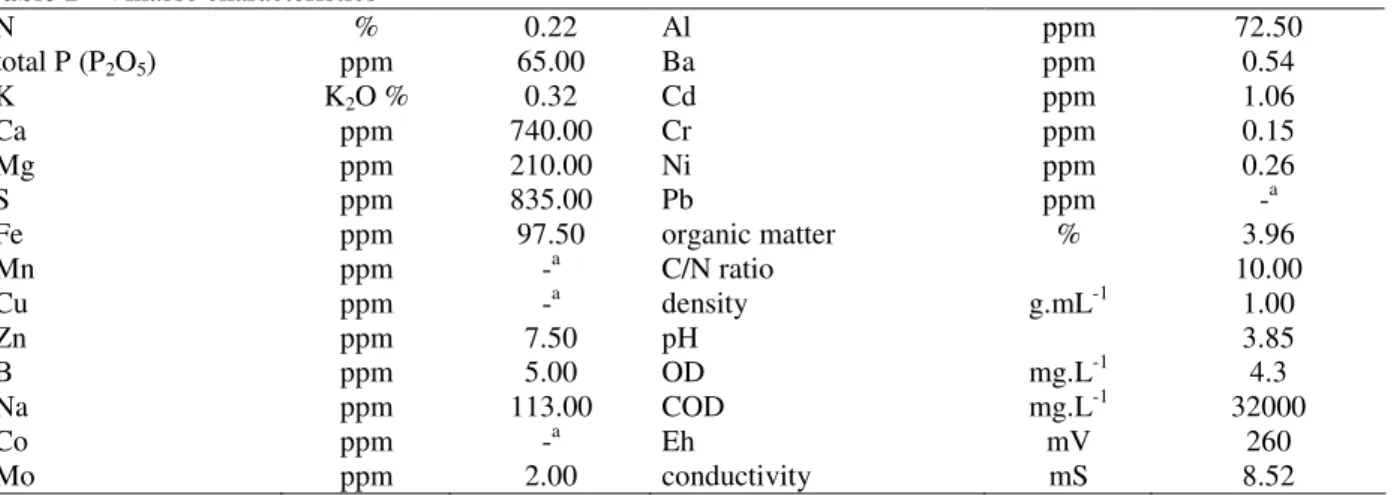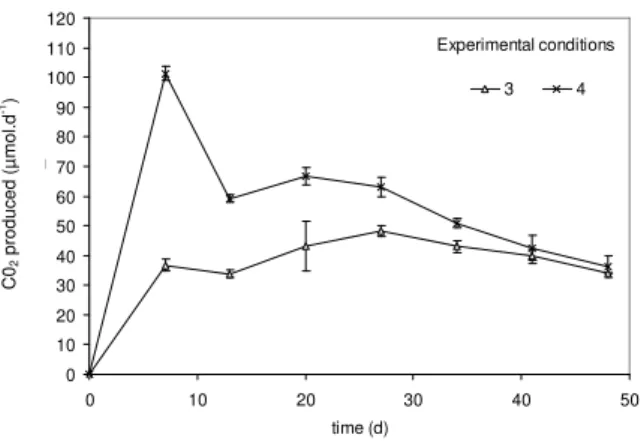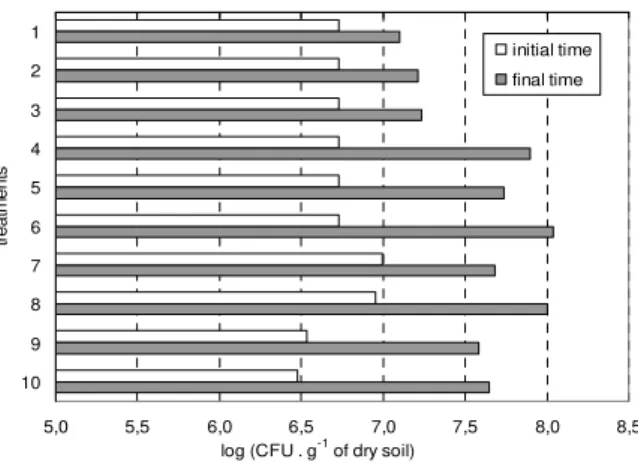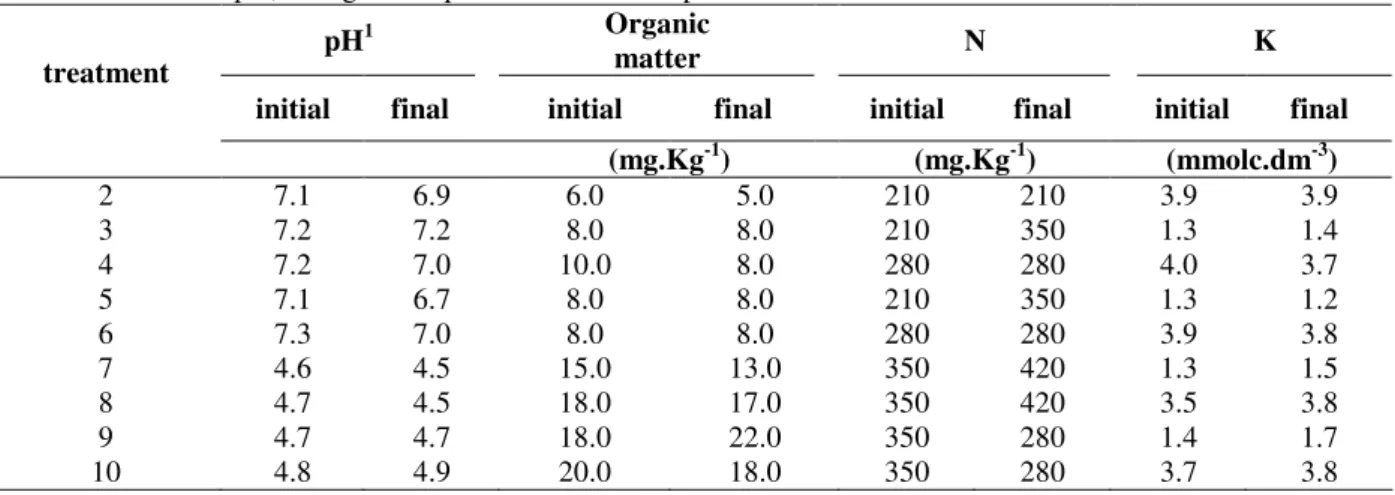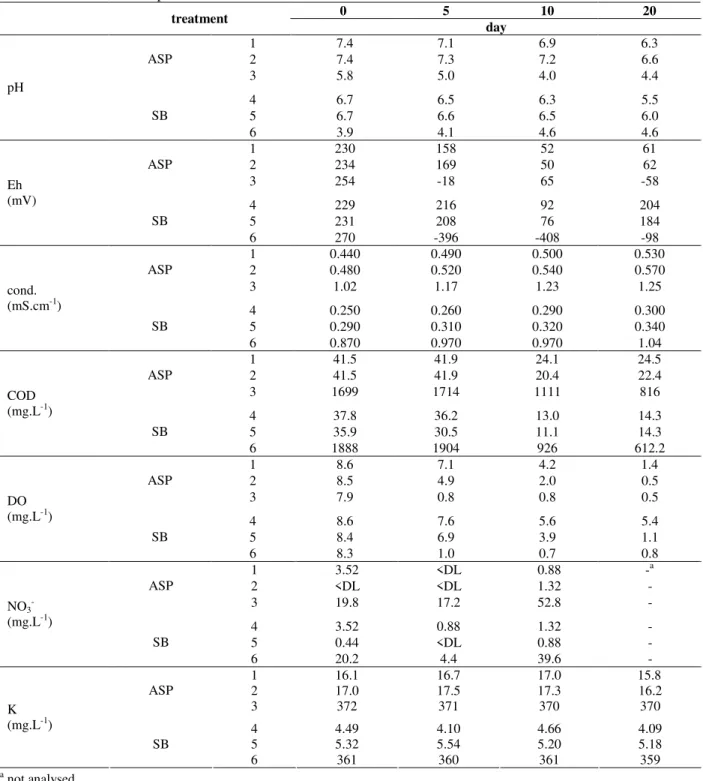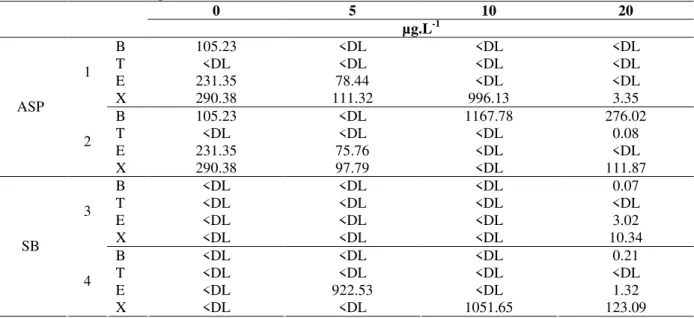Vol.52, n. 4: pp. 1043-1055, July-August 2009
ISSN 1516-8913 Printed in Brazil BRAZILIAN ARCHIVES OF
BIOLOGY AND TECHNOLOGY A N I N T E R N A T I O N A L J O U R N A L
The use of Vinasse as an Amendment to Ex-Situ
Bioremediation of Soil and Groundwater Contaminated
with Diesel Oil
Adriano Pinto Mariano
1,2 *, Sérgio Henrique Rezende Crivelaro
2, Dejanira de Franceschi
de Angelis
2and Daniel Marcos Bonotto
11Instituto de Geociências e Ciências Exatas; Rio Claro - SP - Brasil. 2Departamento de Bioquímica e
Microbiologia; Instituto de Biociências; Universidade Estadual Paulista; Av. 24-A, 1515; C.P.: 199; 13506-900; Rio Claro - SP - Brasil
ABSTRACT
This work investigated the possibility of using vinasse as an amendment in ex-situ bioremediation processes. Groundwater and soil samples were collected at petrol stations. The soil bioremediation was simulated in Bartha biometer flasks, used to measure the microbial CO2 production, during 48 days, where vinasse was added at a
concentration of 33 mL.Kg-1 of soil. Biodegradation efficiency was also measured by quantifying the total petroleum hydrocarbons (TPH) by gas chromatography. The groundwater bioremediation was carried out in laboratory experiments simulating aerated (bioreactors) and not aerated (BOD flasks) conditions. In both the cases, the concentration of vinasse was 5 % (v/v) and different physicochemical parameters were evaluated during 20 days. Although an increase in the soil fertility and microbial population were obtained with the vinasse, it demonstrated not to be adequate to enhance the bioremediation efficiency of diesel oil contaminated soils. The addition of the vinasse in the contaminated groundwaters had negative effects on the biodegradation of the hydrocarbons, since vinasse, as a labile carbon source, was preferentially consumed.
Key words: Bioremediation, soil, groundwater, diesel oil, biostimulation, vinasse
*Author for correspondence:adrianomariano@yahoo.com.br
INTRODUCTION
Vinasse is a byproduct of the alcohol distillation process, whose disposal represents a major environmental concern mainly due to the great volume generated and its high biological oxygen demand. In general, to produce one liter of alcohol, 10 to 15 liters of vinasse are produced, depending on cane quality and the industrial process (Cortez et al., 1992), which corresponds to approximately 170 billion liters per year of this
residue in Brazil (Agrianual, 2004). Considering that every two liters of vinasse is equivalent to the domestic sewage generated by one person per day (Lukssemberg et al., 1980 apud Gonçalves and
Silva, 2000), the annual production of vinasse corresponds to the domestic sewage produced by an estimate population of 232 million people during one year.
Mariano, A. P. et al
Braz. Arch. Biol. Technol. v.52 n.4: pp. 1043-1055, July/Aug 2009 1044
variable, depending, among other factors, on water availability, sugar-cane characteristics and the fermentation and distillation processes employed (Ferraz et al., 1986). In general, vinasse presents high turbidity and low pH, with high levels of organic matter (mainly glycerol, a soluble carbon source), potassium, calcium and moderate amounts of nitrogen and phosphorus (Rodella et al., 1983; Tauk, 1987; Gómez and Rodríguez, 2000).
In Brazil, it is very common to dispose the vinasse in agricultural fields, a process called ferti-irrigation, as a partial or total substitute for mineral fertilizers, mainly potassium. This idea is a more environmental friendly option than the previous disposal, when vinasse was discharged in rivers nearby the usines, and had a good acceptance by the distilleries due to its technical simplicity and economic advantages (Corazza, 1999). In São Paulo State, where the majority of the sugar cane fields is located, this agricultural procedure is controlled by a specific legislation that determines how to calculate the vinasse dosage (Cetesb, 2005b). Vinasse addition at adequate rates has demonstrated to increase sugar cane production. However, in a long term, the intensive application of vinasse can increase the soil salinity (Corazza, 1999), affect the sugar cane quality and contaminate the groundwater (Gonçalves and Silva, 2000). Some works have shown that vinasse can modify temporarily some soil chemical and biological characteristics, such as pH, organic carbon, changeable acidity (Camargo et al., 1987) and the microbial activity and biomass (Minhoni and Cerri, 1987). Ramalho and Sobrinho (2001) observed that the use of vinasse in large scale did not alter significantly the heavy metals concentration in soil. Fontes (1988), Cardoso (1988) and Itamar (1987) observed that vinasse increased the concentrations of calcium, magnesium, organic matter and mainly potassium, causing an elevation of the soil electrical conductivity.
Considering that the ethanol production in Brazil is in expansion due to a rising internal and world-wide demand for alternative energy sources and that soils have a limited support capability to receive the vinasse, there is a need for alternative methods to treat or re-use the vinasse. Corazza (1999) described alternative technologies where the vinasse could be recycled in the fermentation process, treated in anaerobic reactors, or used to produce yeast, animal food and employed in the civil construction. In relation to the use of vinasse
as an amendment to the biodegradation of pollutants, Prata et al. (2001) evaluated the effects of vinasse on the degradation and sorption of the herbicide ametryne. The vinasse addition increased the microbial activity and the degradation of ametryne, and the sorption was not affected. Crivelaro (2005) reported an increase in the microbial population, mainly fungi, when studying the use of vinasse as an amendment to accelerate the biodegradation of oily sludge in soil. Aiming to offer an alternative of destination for the vinasse, this work investigated the possibility of using vinasse as an amendment in ex-situ bioremediation processes by supplying the nutrients and as an extra labile carbon source that could increase the microorganisms population. As vinasse represents a potential source of pollution, ex-situ treatments are preferable since controlled processes minimize any risk of additional contamination due to the vinasse.
MATERIALS AND METHODS
Vinasse characteristics
Vinasse was collected at the Santa Lúcia usine (Araras-SP, Brazil) and stored frozen until its use. The physicochemical analyses described in Table 1 were performed by Icasa laboratory (Instituto Campineiro de Análise de Solo e Adubo – Icasa), according to the methodology proposed by Embrapa (1997), and the following parameters: dissolved oxygen (DO) (Digimed DM4), chemical oxygen demand (COD) (Cetesb, 1994), redox potential (Eh) (Hanna HI 8314) and conductivity (Analion C-701, electrode Analion C 801-1) were determined at Unesp (Rio Claro-SP, Brazil).
Soil respirometric test
samples were stored at 5 oC. Table 2 summarizes
some physicochemical characteristics of these soil samples. Values of heavy metals concentrations were not above the more restricted levels set by the Cetesb (São Paulo Environmental Agency - Brazil) and by the Dutch list (Cetesb, 2005a). The physicochemical analyses were performed by Icasa laboratory according to the methodology proposed by Embrapa (1997), except the following
parameters: total nitrogen (laboratory
“PIRASOLO – Laboratório Agrotécnico
Piracicaba”, according to Embrapa (1997)); grain size distribution (ABNT, 1984) and the moisture content (obtained by the oven drying method). Determination of the total petroleum hydrocarbons (TPH) content was carried out by the “Analytical Technology” laboratory by gas chromatography with the flame ionization detector (FID) according to the US Environmental Protection Agency (USEPA) methodology SW-846/8015.
Table 1 - Vinasse characteristics
N % 0.22 Al ppm 72.50
total P (P2O5) ppm 65.00 Ba ppm 0.54
K K2O % 0.32 Cd ppm 1.06
Ca ppm 740.00 Cr ppm 0.15
Mg ppm 210.00 Ni ppm 0.26
S ppm 835.00 Pb ppm -a
Fe ppm 97.50 organic matter % 3.96
Mn ppm -a C/N ratio 10.00
Cu ppm -a density g.mL-1 1.00
Zn ppm 7.50 pH 3.85
B ppm 5.00 OD mg.L-1 4.3
Na ppm 113.00 COD mg.L-1 32000
Co ppm -a Eh mV 260
Mo ppm 2.00 conductivity mS 8.52
a not detected.
Table 2 - Soil samples characteristics
ASP SB RC
pH (CaCl2) 6.7 5.0 6.7
moisture content (%) 16.6 17.6 8.8
organic carbon (%) 1.39 0.99 0.29
total nitrogen (%) 0.08 0.07 0.02
available phosphorus (ppm) 6.0 3.0 2.0
C:N:P ratio 100 : 5.75 : 0.043 100 : 7.08 : 0.03 100 : 6.89 : 0.10
(mmolc.dm-3)
K 1.7 1.4 1.1
Ca 100 20 15
Mg 8 6 2
H+Al 11 16 10
Al -a -a -a
CECb 121.8 44.1 28.7
grain size distribution (%)
sand 78.7 66.7 81.4
silt 16.3 18.3 7.3
clay 5.0 15.0 11.3
micronutrients(ppm) heavy metals (ppm)
S Na Fe Mn Cu Zn B Co Mo Ba Cd Cr Ni Pb
ASP 24 24 136 9.4 1.6 1.7 0.24 -a 0.03 9.73 0.03 2.10 0.44 5.9
SB 14 17 150 49.1 1.1 2.2 0.21 2.29 -a 55.81 0.19 4.92 1.53 7.96
RC 12 13 19 3.0 0.6 7.3 0.15 0.56 -a 4.06 0.12 9.93 0.30 7.10
a not detected
Braz. Arch. Biol. Technol. v.52 n.4: pp. 1043-1055, July/Aug 2009 1046
In order to verify the influence of the bioaugmentation technique in the biodegradation of diesel oil, batch biodegradation experiments (48 days) were carried out in Bartha biometer flasks (250 mL) used to measure the microbial CO2
production (Bartha and Pramer, 1965; Régis and Bidoia, 2005; Inazaki et al., 2004; Mariano et al.,
2007a). Mineralization studies involving
measurements of total CO2 production can provide
excellent information on the biodegradability potential of hydrocarbons (Balba et al., 1998). The experiments were divided into two parts described in Table 3. In the first one, a diesel oil
contamination of the RC soil was simulated by adding diesel oil purchased from a local petrol station or a weathered diesel oil collected from the groundwater at ASP petrol station (6 mg.Kg-1 of
soil). In the second part, experiments with ASP and SB soils were carried out. For both the parts, vinasse was added at a concentration of 33 mL.Kg-1 of soil, which changed the water content
of the soils to 11.9 (RC), 19.0 (ASP) and 19.0 % (SB). In the treatments where vinasse was not added (controls), the water content was corrected in relation to the other treatments by adding distilled water.
Table 3 - Soil respirometric - experimental conditions
treatment soil experimental condition
1 RC soil (control)
2 RC soil + vinasse (control)
3 RC soil + weathered diesel
4 RC soil + weathered diesel + vinasse
5 RC soil + commercial diesel
6 RC soil + commercial diesel + vinasse
7 ASP soil (control)
8 ASP soil + vinasse
9 SB soil (control)
10 SB soil + vinasse
For each experimental condition, the biometer flasks were prepared in triplicates (3 x 50 g of soil) and incubated at 27 oC in the dark. The CO
2
produced was trapped in a 10.0 mL solution of KOH (0.2 N), located in the side-arm of the biometer. This solution was periodically withdrawn by syringe, and the amount of carbon dioxide absorbed was then measured by titrating the residual KOH (after the addition of barium chloride solution (1 mL; 1.0 N) used to precipitate the carbonate ions) with a standard solution of HCl (0.1 N). During this procedure, the biometers were aerated during 1.5 minute through the ascarite filters.
At the end of the experiments, replicates of each treatment were thoroughly mixed together for physicochemical and microbiological analyses. Total heterotrophic bacteria were counted by using the pour plate technique on plate count agar (Acumedia, USA). Plate count of the bacterial soil population was performed as follows: samples of 1 g of soil were added to 9 mL of 0.85 % sterile saline solution in test tubes and agitated mechanically for 2 minutes. After appropriate serial dilutions, 1 mL of the suspension were spread over the surface of duplicate petri dishes
and incubated at 35 oC for 48 h. The total
heterotrophic bacteria count was carried out at the beginning and at end of the respirometric experiments.
Groundwater experiments
Groundwater samples were collected at petrol stations ASP and SB (Mariano et al., 2007b) and stored at 5 oC until the biodegradation experiments
were performed. In order to verify the influence of the addition of vinasse in the biodegradation of the diesel oil present in the groundwater, two biodegradation experiments were set up. The first was carried out in BOD flasks (300 mL) that were incubated in the dark during 20 days at 20.0±0.2
oC. Treatments with vinasse were compared to a
standard bioremediation technique, the addition of nutrients, where the nitrogen and phosphorus correction was performed using solutions of (NH4)2SO4 and KH2PO4, respectively. Table 4
summarizes the experimental conditions. To provide the same conditions to the treatments without vinasse, 5 % of the reacting medium volume corresponds to distillate water.
at intervals of 0, 5, 10 and 20 days: dissolved oxygen (DO) (Digimed DM4); pH (Analion IA601); redox potential (Eh) (Hanna HI 8314); conductivity (Analion C-701, electrode Analion C 801-1); chemical oxygen demand (COD) (Cetesb, 1994); potassium and nitrate ions concentration (Hach DR 2000); BTEX (benzene, toluene, ethylbenzene and xylenes) and PAH (polyaromatic hydrocarbons) concentrations, being the latter only at initial and final times. At the mentioned intervals, for each treatment, the DO was measured in two flasks and then they were mixed together and appropriate aliquots for each analysis were withdrawn.
The BTEX and PAH analyses were performed by “Laboratório de Química Ambiental (IQSC-USP)” according to the USEPA methodologies 8015 and 8270, respectively.
The second biodegradation experiment with the groundwater was carried out in four aerated bioreactors (900 mL), whose experimental conditions are listed in Table 5. To provide the same conditions to the treatments without vinasse, 5 % of the reacting medium volume corresponded to distilled water. At the same intervals of the first
biodegradation experiment, the BTEX
concentration was measured. The chemical oxygen demand (COD) and the PAH concentration were determined only at initial and final times.
Table 4 - Groundwater experiment – BOD flasks
treatment groundwater experimental condition
1 ASP groundwater (control)
2 ASP groundwater + nutrients (COD:N:P = 100:5:1)
3 ASP groundwater + vinasse (5% v/v)
4 SB groundwater (control)
5 SB groundwater + nutrients (COD:N:P = 100:5:1)
6 SB groundwater + vinasse (5% v/v)
COD = chemical oxygen demand
Table 5 - Groundwater experiment – aerated bioreactors
treatment groundwater experimental condition
1 ASP groundwater (control)
2 ASP groundwater + vinasse (5% v/v)
3 SB groundwater (control)
4 SB groundwater + vinasse (5% v/v)
RESULTS AND DISCUSSION
Soil respirometric test
The daily CO2 productions in the respirometric
experiments are represented in Figures 1 to 5, where each error bar represents 1 SD (standard deviation) of three replicates. The evolution of the CO2 production in treatment 2 (Fig. 1) showed that
the vinasse was almost totally biodegraded in
approximately 20 days after being applied to RC soil (without addition of diesel oil). When considering the experiments with contaminated soils (Fig. 2 to 5), a similar behavior was observed, i.e. the CO2 production in experiments
with vinasse initially differentiated from the controls and after similar period, it decreased until reaching values next to the controls.
Experimental conditions
0 10 20 30 40 50 60 70 80 90 100
0 10 20 30 40 50
time (d)
C
O
2
p
ro
d
u
c
e
d
(
m
o
l.
d
-1)
1 2
Figure 1 - CO2 production during incubation of treatments 1 (RC soil) and 2 (RC soil + vinasse).
C
02
p
ro
d
u
c
e
d
(
µ
m
o
l.d
Mariano, A. P. et al
Braz. Arch. Biol. Technol. v.52 n.4: pp. 1043-1055, July/Aug 2009 1048 Experimental conditions 0 10 20 30 40 50 60 70 80 90 100 110 120
0 10 20 30 40 50
time (d) C O 2 p ro d u c e d ( m o l. d -1) 3 4
Figure 2 - CO2 production during incubation of treatments 3 (RC soil + weathered diesel) and 4
(RC soil + weathered diesel + vinasse).
Experimental conditions 0 10 20 30 40 50 60 70 80 90 100 110 120 130 140 150 160
0 10 20 30 40 50
time (d) C O 2 p ro d u c e d ( m o l. d -1) 5 6
Figure 3 - CO2 production during incubation of treatments 5 (RC soil + commercial diesel) and 6
(RC soil + commercial diesel + vinasse).
Experimental conditions 0 10 20 30 40 50 60 70 80
0 10 20 30 40 50
time (d) C O 2 p ro d u c e d ( m o l. d -1) 7 8
Figure 4 - CO2 production during incubation of treatments 7 (ASP soil) and 8 (ASP soil +
Experimental conditions
0 10 20 30 40 50 60 70 80
0 10 20 30 40 50
time (d)
C
O
2 p
ro
d
u
c
e
d
(
m
o
l.
d
-1)
9 10
Figure 5 - CO2 production during incubation of treatments 9 (SB soil) and 10 (SB soil + vinasse).
The total heterotrophic bacteria counts at initial and final times of incubation (Fig. 6) showed that in the treatments with vinasse, the bacterial population was higher at the final time than in the controls. This increase in the soil microbial population caused by the vinasse has also been reported by Prata et al. (2001) and Crivelaro (2005) in their biodegradation experiments. However, as observed by Hickman and Novak (1989), the total microbial biomass could be a poor predictor for determining biodegradation potential, mainly because the active biomass could differ in species composition and in metabolic regimes.
Certainly these additional microorganisms
preferentially biodegraded the more labile carbon
sources as the glycerol present in the vinasse (Rodella et al., 1983; Prata et al., 2001); otherwise, a marked decrease in the CO2 production after the
consumption of the vinasse would not be observed. Moreover, there was practically no difference in the biodegradation efficiencies in terms of concentrations of hydrocarbons between the treatments (RC and ASP soils) with the addition of vinasse and the controls (Table 6). The results with SB soil, where the biodegradation efficiency was clearly superior in the control, indicated that the preferential consumption of the vinasse could also delay the bioremediation process.
5,0 5,5 6,0 6,5 7,0 7,5 8,0 8,5
1 2 3 4 5 6 7 8 9 10
tr
e
a
tm
e
n
ts
log (CFU . g-1 of dry soil)
initial time final time
Figure 6 - Total heterotrophic bacteria counts at initial and final time of the treatments (soil
respirometric test).
C
02
p
ro
d
u
c
e
d
(
µ
m
o
l.d
Mariano, A. P. et al
Braz. Arch. Biol. Technol. v.52 n.4: pp. 1043-1055, July/Aug 2009 1050
Table 6 - Concentration of hydrocarbons at the beginning (1) and end (2) of the respirometric treatments. Values between parentheses indicate the biodegradation efficiency (%).
treatment total
n-alkanes pristine phytane TRH UCM TPH
1 2 1 2 1 2 1 2 1 2 1 2
(mg.Kg-1)
1 -a - - - - - - - - - 104.3 -
2 -a - - - - - - - - - - -
3 <DL1 <DL2 59.0 67.0 35.7 38.0 711 550 (22.6) 4444 4313 (2.9) 5155 4864 (5.6)
4 <DL1 <DL2 59.0 63.0 35.7 36.0 711 546 (23.2) 4444 4326 (2.7) 5155 4872 (5.5)
5 499.2 <DL2 (>96.3) 43.5 38.3 (11.5) 23.8 22.0 (7.6) 1231 519 (57.8) 4199 4131 (1.6) 5431 4650(14.4)
6 499.2 <DL2 (>96.3) 43.5 35.0 (19.5) 23.8 21.1 (11.3) 1231 502 (59.2) 4199 4160 (0.9) 5431 4663(14.1)
7 <DL3 4.1 <DL3 2.4 <DL3 1.3 61.9 35.0 (43.5) 722 228 (68.4) 784 263.2(66.4)
8 <DL3 3.4 <DL3 2.0 <DL3 1.1 61.9 37.4 (39.6) 722 204 (71.7) 784 241.0(69.3)
9 <DL4 <DL4 32.5 35.7 27.5 31.8 510 587 3277 1903 (41.9) 3787 2489 (34.3)
10 <DL4 <DL5 32.5 <DL5 (9.7) 27.5 <DL5 (>28.7) 510 349 (31.6) 3277 3183(2.9) 3787 3532(6.7)
a not analysed
DL (detection limit) = (1) 3.6 mg.Kg-1; (2) 18.5 mg.Kg-1; (3) 4.0 mg.Kg-1; (4) 2.0 mg.Kg-1; (5) 19.6 mg.Kg-1;
TRH - Total Resolvable Hydrocarbons; UCM - Unresolved Complex Mixture; TPH - Total Petroleum Hydrocarbons
Table 7 shows the values of pH and concentrations of organic matter, nitrogen and potassium at the initial and final times of experiments. Comparing the treatments with the addition of vinasse to their controls, the values of pH were practically not altered; the organic matter, nitrogen (only in RC soil) and potassium contents increased with the
addition of vinasse. The potassium concentration in the soil and its cation exchange capacity are the parameters used to calculate the vinasse dosage to be applied in agricultural fields according to the Brazilian legislation (Cetesb, 2005b), since this residue has a high concentration of this element.
Table 7 - Values of pH, nitrogen and potassium in the respirometric treatments.
pH1 Organic
matter N K
treatment
initial final initial final initial final initial final
(mg.Kg-1) (mg.Kg-1) (mmolc.dm-3)
2 7.1 6.9 6.0 5.0 210 210 3.9 3.9
3 7.2 7.2 8.0 8.0 210 350 1.3 1.4
4 7.2 7.0 10.0 8.0 280 280 4.0 3.7
5 7.1 6.7 8.0 8.0 210 350 1.3 1.2
6 7.3 7.0 8.0 8.0 280 280 3.9 3.8
7 4.6 4.5 15.0 13.0 350 420 1.3 1.5
8 4.7 4.5 18.0 17.0 350 420 3.5 3.8
9 4.7 4.7 18.0 22.0 350 280 1.4 1.7
10 4.8 4.9 20.0 18.0 350 280 3.7 3.8
1CaCl
2
Groundwater experiments
Table 8 shows the physicochemical parameters measured during the incubation of the BOD flasks. In general, the treatments with addition of nutrients had similar behavior in relation to controls, except for the dissolved oxygen that was more consumed in the former, indicating an intensification of the biodegradation rates. It was possible to observe that with the addition of the vinasse, there were a series of inhibitory factors in
caused an increase in the concentration of nitrate above the limit (10 mg.L-1) determined by the
Brazilian legislation on drinkable waters for public use (Portaria n.518/2004 MS).
In terms of concentration of the hydrocarbons BTEX (Table 9), the remaining concentrations mainly of xylenes, the more recalcitrant ones
(Kaplan et al., 1997), showed that the treatments
with vinasse had the worst performances. Most of the values of concentrations of the poliaromatic hydrocarbons (PAH) were under the detection limit, for this reason, it was not possible to identify any influence of the treatments in the
biodegradation of these hydrocarbons.
Table 8 - Groundwater experiment – BOD flasks.
0 5 10 20
treatment
day
1 7.4 7.1 6.9 6.3
2 7.4 7.3 7.2 6.6
ASP
3 5.8 5.0 4.0 4.4
4 6.7 6.5 6.3 5.5
5 6.7 6.6 6.5 6.0
pH
SB
6 3.9 4.1 4.6 4.6
1 230 158 52 61
2 234 169 50 62
ASP
3 254 -18 65 -58
4 229 216 92 204
5 231 208 76 184
Eh (mV)
SB
6 270 -396 -408 -98
1 0.440 0.490 0.500 0.530
2 0.480 0.520 0.540 0.570
ASP
3 1.02 1.17 1.23 1.25
4 0.250 0.260 0.290 0.300
5 0.290 0.310 0.320 0.340
cond.
(mS.cm-1)
SB
6 0.870 0.970 0.970 1.04
1 41.5 41.9 24.1 24.5
2 41.5 41.9 20.4 22.4
ASP
3 1699 1714 1111 816
4 37.8 36.2 13.0 14.3
5 35.9 30.5 11.1 14.3
COD
(mg.L-1)
SB
6 1888 1904 926 612.2
1 8.6 7.1 4.2 1.4
2 8.5 4.9 2.0 0.5
ASP
3 7.9 0.8 0.8 0.5
4 8.6 7.6 5.6 5.4
5 8.4 6.9 3.9 1.1
DO
(mg.L-1)
SB
6 8.3 1.0 0.7 0.8
1 3.52 <DL 0.88 -a
2 <DL <DL 1.32 -
ASP
3 19.8 17.2 52.8 -
4 3.52 0.88 1.32 -
5 0.44 <DL 0.88 -
NO3
-(mg.L-1)
SB
6 20.2 4.4 39.6 -
1 16.1 16.7 17.0 15.8
2 17.0 17.5 17.3 16.2
ASP
3 372 371 370 370
4 4.49 4.10 4.66 4.09
5 5.32 5.54 5.20 5.18
K
(mg.L-1)
SB
6 361 360 361 359
a not analysed
Mariano, A. P. et al
Braz. Arch. Biol. Technol. v.52 n.4: pp. 1043-1055, July/Aug 2009 1052
Table 9 - Groundwater experiment – BOD flasks – BTEX concentration
0 5 10 20
µg.L-1
B 105.23 <DL <DL <DL
T <DL 9.07 <DL <DL
E 231.35 110.18 <DL <DL
1
X 290.38 493.04 396.65 <DL
B 105.23 <DL 400.69 <DL
T <DL <DL <DL <DL
E 231.35 452.7 <DL <DL
2
X 290.38 166.67 254.63 <DL
B 105.23 <DL <DL 9.081
T <DL <DL <DL 1.08
E 231.35 449.59 1775.73 0.06
ASP
3
X 290.38 730.65 2545.67 98.12
B <DL <DL <DL 60.33
T <DL <DL <DL 1.09
E <DL <DL <DL <DL
4
X <DL 149.57 <DL 1.23
B <DL <DL <DL 1.04
T <DL <DL <DL <DL
E <DL <DL <DL <DL
5
X <DL <DL <DL <DL
B <DL 658.24 731.22 3.12
T <DL <DL <DL 0.092
E <DL <DL 694.49 <DL
SB
6
X <DL 1610.85 1163.25 134.02
B-benzene; T-toluene; E-ethylbenzene; X-xylenes
DL (detection limit) = 0.004 µg.L-1
The previous results showed that the high concentration of organic matter in the vinasse caused a rapid consumption of the dissolved oxygen in the groundwater. Thus, aiming to overcome this process deficiency, the second biodegradation experiment was based on an aerated system. The results obtained with the aerated bioreactors are shown in Tables 10 and 11. Treatments with vinasse had a better performance in terms of reduction of the chemical oxygen demand (COD) (Table 10). However, the final values were still very high (up to 40 times in
relation to the controls), indicating that even in 20 days the vinasse was not totally biodegraded. Similarly to the BOD flasks experiment, the addition of vinasse had a negative influence on the biodegradation of the hydrocarbons, as suggested by the final concentrations of benzene (ASP) and xylenes (ASP and SB) (Table 11). No influence of the vinasse in the concentration of the polyaromatic hydrocarbons (PAH) could be identified, since most of these values were under the detection limit.
Table 10 - Groundwater experiment – aerated bioreactors
0 20 reduction
treatment
day %
1 41.5 16.3 60.7
ASP 2 1699 408.2 76.0
3 37.8 12.2 67.7
COD (mg.L-1)
Table 11 - Groundwater experiment – aerated bioreactors – BTEX concentration
0 5 10 20
µg.L-1
B 105.23 <DL <DL <DL
T <DL <DL <DL <DL
E 231.35 78.44 <DL <DL
1
X 290.38 111.32 996.13 3.35
B 105.23 <DL 1167.78 276.02
T <DL <DL <DL 0.08
E 231.35 75.76 <DL <DL
ASP 2
X 290.38 97.79 <DL 111.87
B <DL <DL <DL 0.07
T <DL <DL <DL <DL
E <DL <DL <DL 3.02
3
X <DL <DL <DL 10.34
B <DL <DL <DL 0.21
T <DL <DL <DL <DL
E <DL 922.53 <DL 1.32
SB
4
X <DL <DL 1051.65 123.09
B-benzene; T-toluene; E-ethylbenzene; X-xylenes
DL (detection limit) = 0.004 µg.L-1
CONCLUSIONS
Although an increase in the soil fertility and microbial population were obtained with the vinasse, it demonstrated not to be adequate to enhance the bioremediation efficiency of diesel oil contaminated soils. The addition of the vinasse in the contaminated groundwaters had negative effects on the biodegradation of the hydrocarbons, since vinasse, as a labile carbon source, was preferentially consumed. Thus, the use of vinasse as an amendment to ex-situ bioremediation processes showed not to be efficient in the studied conditions.
ACKOWLEDGMENTS
The authors acknowledge the Agência Nacional do Petróleo, Gás Natural e Biocombustíveis (ANP) (PRH-05), the petrol stations owners, and the Santa Lúcia usine.
RESUMO
Este trabalho investigou a possibilidade de se usar a vinhaça como um agente estimulador de processos de biorremediação ex-situ. Amostras de
água subterrânea e solo foram coletadas em três postos de combustíveis. A biorremediação do solo
foi simulada em frascos de Bartha, usados para medir a produção de CO2, durante 48 dias, onde a
vinhaça foi adicionada a uma concentração de 33 mL.Kg-1 de solo. A eficiência de biodegradação
também foi medida pela quantificação de hidrocarbonetos totais de petróleo (TPH) por cromatografia gasosa. A biorremediação da água subterrânea foi realizada em experimentos
laboratoriais simulando condições aeradas
(bioreatores) e não aeradas (frascos de DBO). Em ambos os casos, a concentração de vinhaça foi de 5 % (v/v) e diferentes parâmetros físico-químicos foram avaliados durante 20 dias. Embora um aumento da fertilização e da população microbiana do solo foram obtidos com a vinhaça, esta estratégia não se mostrou adequada em aumentar a
eficiência da biorremediação dos solos
contaminados com óleo diesel. A adição de vinhaça às águas subterrâneas contaminadas teve
efeitos negativos na biodegradação dos
hidrocarbonetos, uma vez que a vinhaça, como uma fonte de carbono facilmente assimilável, foi preferencialmente consumida.
REFERENCES
ABNT - Associação Brasileira de Normas Técnicas (1984), NBR 7181: Solo - Análise Granulométrica. Rio de Janeiro, 13p.
Agrianual (2004), Anuário da agricultura brasileira.
Mariano, A. P. et al
Braz. Arch. Biol. Technol. v.52 n.4: pp. 1043-1055, July/Aug 2009 1054
Balba, M. T., Al-Awadhi, N. and Al-Daher, R. (1998), Bioremediation of oil-contaminated soil: microbiological methods for feasibility assessment and field evaluation. Journal of Microbiological Methods, 32, 155-164.
Bartha, R. and Pramer, D. (1965), Features of a flask and method for measuring the persistence and biological effects of pesticides in soil. Soil Sci. 100, 68-70.
Camargo, O. A., Valadares, J. M. A. S., Berton, R. S., Teófilo Sobrinho, J. and Menk, J. R. F. (1987), Alteração de características químicas de um latossolo vermelho-escuro distrófico pela aplicação de vinhaça.
Boletim Científico do Instituto Agronômico de Campinas, 9, 23.
Cardoso, A. N. (1988), Influência da aplicação de vinhaça em propriedades físicas e químicas de um latossolo vermelho-escuro alico, fase cerrado. Master Dissertation, Universidade Federal de Viçosa, Viçosa. Cetesb – Companhia de Tecnologia de Saneamento Ambiental (1994), Norma técnica L5.121 – Demanda Química de oxigênio (DQO) – Método da oxidação por dicromato de potássio em refluxo. [Company of Environmental Sanitation Technology – Technical Standard L5.121 – Chemical oxygen demand (COD) - Potassium dichromate oxidation in reflux method]. São Paulo.
Cetesb – Companhia de Tecnologia de Saneamento Ambiental (2005a), Relatório de estabelecimento de Valores Orientadores para Solos e Águas Subterrâneas no Estado de São Paulo. [Company of Environmental Sanitation Technology]. Technical report.
Cetesb – Companhia de Tecnologia de Saneamento Ambiental (2005b), Norma Técnica P4.231 - Vinhaça - Critérios e Procedimentos para Aplicação no Solo Agrícola. [Company of Environmental Sanitation Technology – Technical Standard P4.231 Vinasse – Criteria and Procedures for Application in Agricultural soil]. São Paulo.
Corazza, R. I. (1999), Reflexões sobre o papel das políticas ambientais de ciência e tecnologia na modelagem de opções produtivas ‘mais limpas’ numa perspectiva evolucionista: um estudo sobre o problema da disposição da vinhaça. Paper presented at III Encontro Nacional da Sociedade Brasileira de Economia Ecológica, Recife.
Corseuil, H. X. and Alvarez, P. J. J. (1996), Natural bioremediation perspective for BTX-contaminated groundwater in Brazil: effect of ethanol. Wat. Sci. Tech., 34 (7-8), 311-318.
Cortez, L., Magalhães, P. and Happi, J. (1992), Principais subprodutos da agroindústria canavieira e sua valorização. Revista Brasileira de Energia, 2 (2),
111.
Crivelaro, S. H. R. (2005), Associação de borra oleosa de refinaria de petróleo e vinhaça visando a
biodegradação. Final paper term (Biological sciences), Instituto de Biociências, Unesp, Rio Claro. Embrapa - Empresa Brasileira de Pesquisa
Agropecuária (1997), Serviço Nacional de Levantamento e Conservação de Solos. Manual de Métodos de Análises de Solos. Rio de Janeiro. Ferraz, C. A. M., Aquarone, E., Krauter, M., Balloni,
W. and Florenzano, G. (1986), Utilização de sub-produtos da indústria alcooleira na obtenção de biomassa de Spirulina máxima. Parte II. Emprego do
resíduo da destilação do mosto fermentado (vinhaça).
Rev. Microbiologia, 17, 15-25.
Fontes, L. E. F. (1988), Propriedades físicas e químicas de um latossolo vermelho-escuro de Goianésia (GO), cultivado com cana-de-açúcar, irrigado com vinhaça. PhD Thesis, Universidade Federal de Viçosa.
Gómez, J. and Rodríguez, O. (2000), Effects of vinasse on sugarcane (Saccharum officinarum) productivity. Rev. Fac. Agron. (LUZ), 17, 318-326.
Gonçalves, C. A. S. and Silva, E. L. (2000), Tratamento Físico-Químico da Vinhaça. Paper presented at XXVII Congresso Interamericano de Engenharia Sanitária e Ambiental. Associação Brasileira de Engenharia Sanitária e Ambiental – ABES. Fortaleza-CE, Brazil.
Hickman, G. T. and Novak, J. T. (1989), Relationship between subsurface biodegradation rates and microbial density. Environ. Sci. Technol., 23,
525-532.
Inazaki, T. H., Pião, A. C. S. and Bidoia, E. D. (2004), Treatment of simulated wastewater containing n-phenyl-n-isopropyl-p-phenylenediamine using electrolysis system with Ti/TiRuO2 electrodes. Braz. Arch. Biol. Technol., 47(6), 983-994.
Itamar, A. (1987), Efeitos da vinhaça em algumas propriedades químicas e físicas de um latossolo vermelho escuro textura media. PhD Thesis, Universidade de São Paulo – ESALQ, Piracicaba. Kaplan, I. R., Galperin, Y., Lu, S. and Lee, R. (1997),
Forensic environmental geochemistry: differentiation of fuel-types, their sources and release time. Org. Geochem., 27, 289-317.
Mariano, A. P., Kataoka, A. P. A. G., Bonotto, D. M. and Angelis, D. F. (2007a), Laboratory study on the bioremediation of diesel oil contaminated soil from a petrol station. Brazilian Journal of Microbiology, 38,
346-353.
Mariano, A. P., Bonotto, D. M. and Angelis, D. F. (2007b), Monitoramento de indicadores geoquímicos e avaliação de biodegradação em área contaminada com óleo diesel. Engenharia Sanitária e Ambiental, 12 (3), 296-304.
Minhoni, M. T. A. and Cerri, C. C. (1987), Decomposição de vinhaça em solo sob diferentes níveis de umidade: liberação de CO2, formação de
Prata, F., Lavorenti, A., Regitano, J. B. and Tornisielo, V. L. (2001), Degradação e sorção de ametrina em dois solos com aplicação de vinhaça. Pesq. agropec. bras., 36 (7), 975-981.
Ramalho, J. F. G. P. and Sobrinho, N. M. B. do A. (2001), Metais pesados em solos cultivados com cana-de-açúcar pelo uso de resíduos agroindustriais.
Revista Floresta e Ambiente. 8 (1), 120-129.
Régis, G. and Bidoia, E. D. (2005), Electrolytic treatment applied to the industrial effluent containing persistent wastes monitored by Bartha respirometric assays. Braz. Arch. Bio.Technol., 48(2), 319-325. Rodella, A. A., Zambello Júnior, E. and Orlando Filho,
J. (1983), Effects of vinasse added to soil on pH and exchangeable aluminum content. Paper presented at
Congress Of The International Society Of Sugar Cane Technologists. Havana, 1983. Proceedings. Havana: Universidad de La Habana, p. 189-214.
Tauk, S. M. (1987), Efeito de doses cumulativas de vinhaça em algumas propriedades do solo sob cerrado e do solo de culturas do milho e cana-de-açúcar no município de Corumbataí, SP. PhD Thesis, Instituto de Biociências, Universidade Estadual Paulista, Rio Claro.
